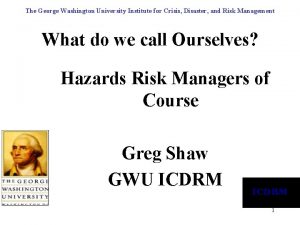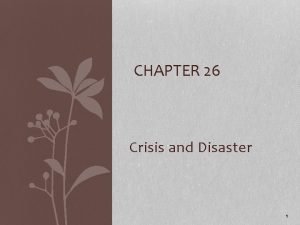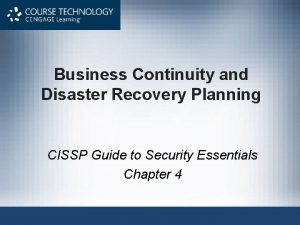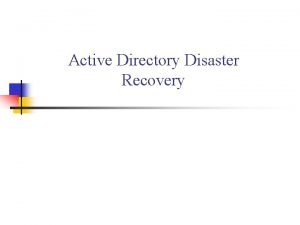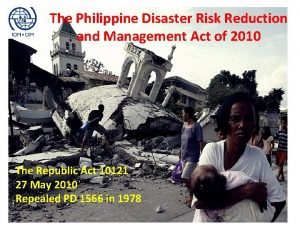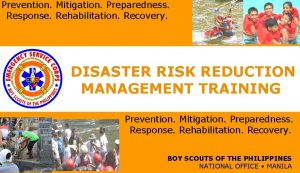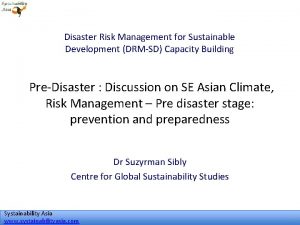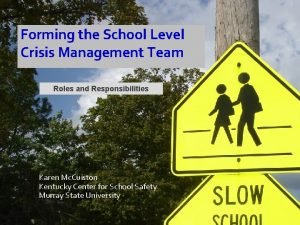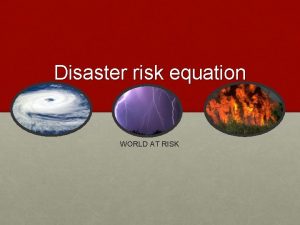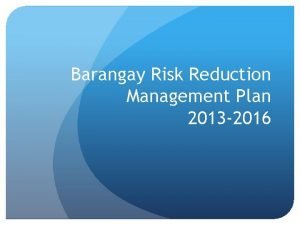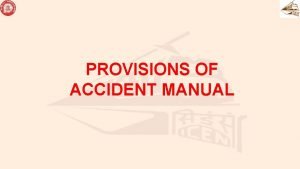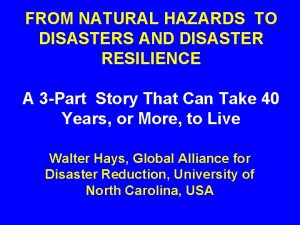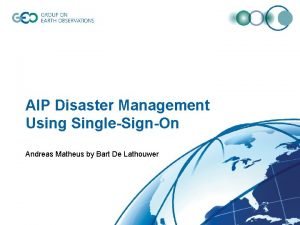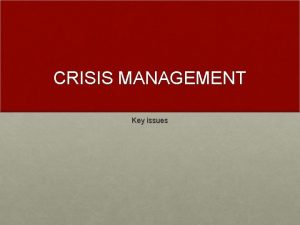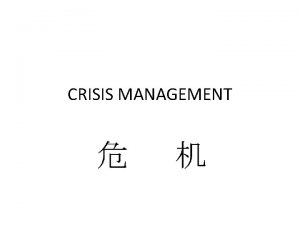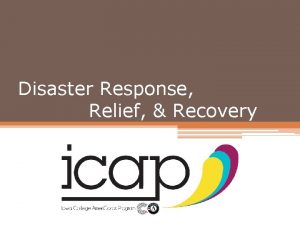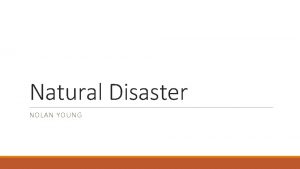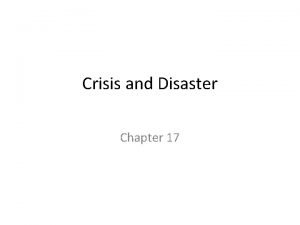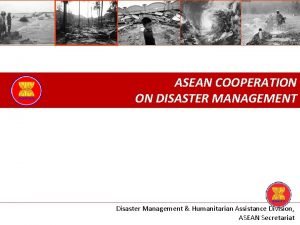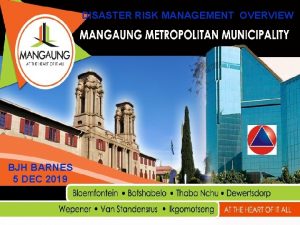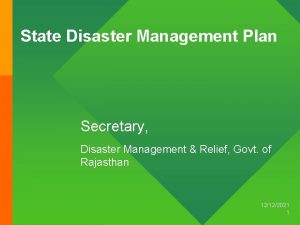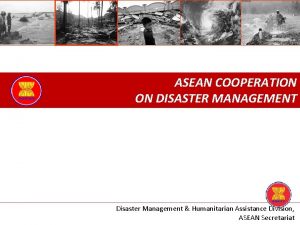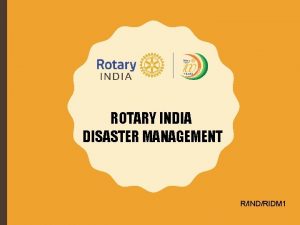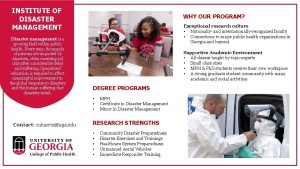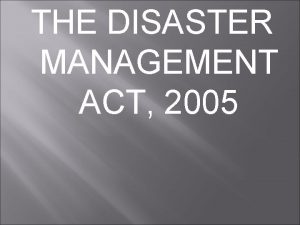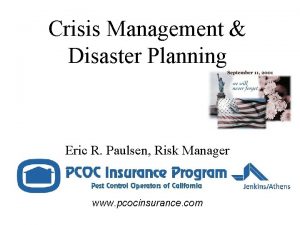Disaster and Crisis Planning and Management Planning and





























- Slides: 29

Disaster and Crisis Planning and Management

Planning and Preparing Logistical Planning • • • Federal State City District Staff Students Parents Volunteers Others

Emergency Preparedness Emergency situations can occur at any time, any place, any where They can be man made or natural They may involve a single individual or large populations They may do minimal or massive damage

Basic Emergency Guidelines Size up the situation Day Time Type of occupancy Type of construction Weather Hazards Size of area Number of people Do not try to rescue anyone unless it is safe for you! Do not add to the problem by becoming a victim too.

Know your Students and Staff First Aid/CPR cards – who has them, who should? Health restrictions - physical restrictions or disabilities Medication concerns – daily, photo-sensitive, 3 day supply? Itinerant staff – personnel and schedules Parent volunteers Other concerns

Safety Concerns Be part of the solution, not part of the problem. Always work in pairs. Wear protective shoes; keep appropriate walking shoes with your emergency kit. Communicate regularly with a partner, group, leader, and people being rescued. Review escape plans with students and staff.

Measures to Ensure Safety Review District Bulletins and Guidelines Plan for the unexpected – think about possible alternative plans. Take all practice drills seriously.

Step One: Triage is divided into two major areas • Psychological Triage • Medical Triage

Psychological Triage Is complex and involves several basic aspects: The rapid identification of victims in possible emotional distress. Establishing priorities for the care of potential victims. Psychological triage will be covered later in the Training.

Medical Triage Medical triage involves two basic components: The identification of victims at greatest risk for early death. Establishing priorities for the care of large numbers of victims START will be used to evaluate victims

START Goals Simple Rapid No special skills required No specific diagnosis Stabilization provided Easy to learn and teach

START (Simple Triage and Rapid Treatment) What is START? The START plan is a simple step-by-step triage and treatment method to be used by the first rescuers responding to a mass casualty incident. It allows the first responders to identify victims at greatest risk for early death. To provide basic stabilization maneuvers.

Who Can Use START? START … was specifically designed for basic emergency personnel. Other groups may choose to use START as the first step in their triage systems.

START Basics RPM Respirations Perfusion Mental Status Where do I start?

Triage Tag • is an identification tag used in a multi casualty incident to prioritize victims for care, (triage). • is a tag to attach to the victim, with four colored code strips to prioritized care.

The Four TRIAGE TAG Colors Green Strip Yellow Strip Red Strip Black Strip Minor – bottom strip -Injuries managed by first aid only -No hospital care needed at the moment Delayed – second from the bottom -Needs hospital care, but not immediate Immediate – third form the bottom -Needs emergency care now -Should receive attention before all others Deceased – fourth from the bottom -Dead or non-salvageable, No CPR is done

What do I do first? Respirations/Ventilation • BLACK • RED • Nothing – open airway, still no breathing, tag black Deceased and move to the next victim. • If person starts to breath, tag red Immediate. • Respirations 30/minute or higher, tag red Immediate. • Respirations under 30/minute, go to the next step – Perfusion.

Perfusion Capillary blanch refill test: Color should return to lips or nail beds within 2 seconds, if so go to Mental Status. If longer than 2 seconds, tag red Immediate. Remember - Control Bleeding

What if the lights are out? The Radial Pulse may be used in reduced lighting If… • Not palpable, tag red immediate • If palpable, go to Mental Status Remember - Control Bleeding

Mental Status Altered mental status, tag red Immediate. Normal mental status, tag yellow - Delayed.

Let the Search Begin… Search Systematically Never search alone! Take the proper supplies, equipment, and keys Select team members according to physical abilities Never enter a building /room without notifying the command center first. When entering a building/room, place a piece of tape on the door forming the first half of an X - / Use a consistent systematically room check When the building/room is clear, complete the X The Search Team will search first, then become part of the Rescue Team

Basic Search Equipment Boxes – one for each search team to store their equipment in Hard Hats/ Gloves/ Goggles/ Vests/ Backpacks/ Dust Masks/ Whistles/ School Maps – one set per member Walkie Talkie – at least one per team Met. Tags/Triage tags/3 x 5 cards with safety pins – to tag victims Clipboards/ pencils/ pens/ markers Log Sheets – to record victims location and condition Flashlights – at least one per team, change batteries annually Masking Tape – to mark doors, people, or ? ? ? Crowbar – to pry open doors and windows, one per team Light weight rope – to string between team members, rope off an area, secure tents, or ? ? ? START guidelines and Basic Vital Sign Guidelines Additional Equipment – any items the school feels is necessary Remember to store in an easily accessible central location

Steps After Initial TRIAGE Establish first aid station Start initial first aid Reassess the “walking wounded” and those previously TRIAGED

Establishing the 1 st Aid Station Generally divided into four smaller stations 1. Triage/Communication Center – organizes, records, receives, and directs 1 st Aid and rescue services. 2. Green Station – Minor, treat and release 3. Yellow Station – Delayed, needs hospital care, but can wait. 4. Red Station – Immediate, needs emergency care now. Should receive attention first. Any victim tagged with Black goes directly to the morgue.

Basic 1 st Aid Equipment Review District Bulletins and Policies Q-5, Q-48, Q-50 First Aid kits - one per 100 students, see supply order catalogs. - Review expiration dates and replace as needed. Stethoscopes/Blood Pressure Cuff with varying cuff sizes Walkie Talkie and Flash Lights Large laminated map of the school and grease pencils Clipboards/ pencils/ pens/ Log Sheets Red/ Yellow/ Green Triage Station Locator Signs Tarps/ Tents/ Blankets/ Pillows

Rescue Team • Rescue members meet at the 1 st Aid station • The Search Team will join the Rescue Team, once they have completed their search • Each team consists of 2 – 4 members • Take appropriate equipment Stretchers, 1 st Aid kits, etc. No one goes anywhere alone

Emergency Classroom Kits Suggested items: Classroom rosters Emergency plans Paper, pencils, pens, crayons, or other age appropriate items Crackers or similar food item Butcher paper to sit on Walking shoes or other items? Chain or rope ladders for second floor classrooms The kit needs to be easy to carry and quickly accessible

Questions? What does your school site need to be safe? Who will you discuss your concerns with? Where will the funding come from? What are the District, State, Federal requirements?

Closing Comments
 George washington crisis management
George washington crisis management Chapter 26 crisis and disaster
Chapter 26 crisis and disaster Gravis grave
Gravis grave Bcp steps cissp
Bcp steps cissp Disaster recovery planning in system analysis and design
Disaster recovery planning in system analysis and design Ad disaster recovery
Ad disaster recovery Cyber disaster planning
Cyber disaster planning Philippine disaster reduction and management act
Philippine disaster reduction and management act A clear concise document which outlines preventive
A clear concise document which outlines preventive National disaster risk reduction and management framework
National disaster risk reduction and management framework Disaster management and sustainable development
Disaster management and sustainable development Crisis management team roles and responsibilities
Crisis management team roles and responsibilities Ford and firestone crisis management
Ford and firestone crisis management Mit crisis management and business continuity
Mit crisis management and business continuity Conclusion on disaster management
Conclusion on disaster management Early warning system in disaster management
Early warning system in disaster management Complete the equation: (+hazard) / capacity=disaster *
Complete the equation: (+hazard) / capacity=disaster * Records management disaster recovery plan
Records management disaster recovery plan Vulnerability disaster management
Vulnerability disaster management Disaster management centre sri lanka
Disaster management centre sri lanka Civil defence disaster management
Civil defence disaster management Barangay disaster risk reduction management plan
Barangay disaster risk reduction management plan Conclusion of disaster management
Conclusion of disaster management Disaster management
Disaster management 4 pillars of disaster management
4 pillars of disaster management Bart de lathouwer
Bart de lathouwer Emerging trends in disaster mitigation
Emerging trends in disaster mitigation Natural disasters conclusion for project
Natural disasters conclusion for project Hotmail
Hotmail Objective of disaster management
Objective of disaster management
